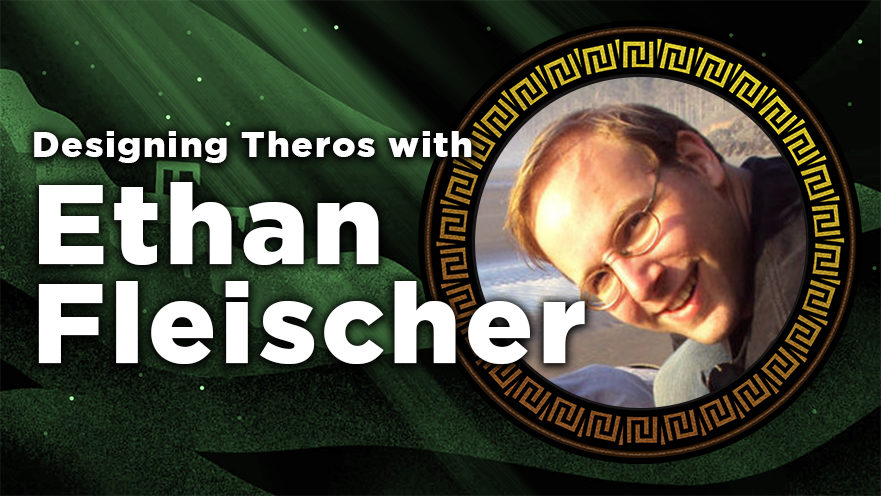Returning to a world Magic has visited before always brings back fond memories and
creates new ones. We see our hero rise and face new monsters, including ones
disguised as gods.
But what about the aspects of Theros’s return we don’t see? Beyond the
Underworld and the cards themselves? To answer this question, I reached out to
Theros expert Ethan Fleischer at Wizards of the Coast. Ethan was on the design
team of Theros and Born of the Gods and was Journey into Nyx’s lead designer. Recent
products he led the design for include Core
Set 2019, Modern Horizons, and Signature Spellbook: Gideon.
In this interview saga, Ethan gives us insight into envisioning and creating Theros Beyond Death!
What was your role in creating Theros Beyond Death?
I am a senior game designer working almost exclusively on Magic. I tend to focus more on the earlier stages of design, what we call Exploratory Design and Vision Design. I’ve led the design of several Magic booster products, as well as quite a few Commander products.
I led both the Exploratory and Vision Design teams for Theros Beyond Death. This involved determining the broad themes of the set and exploring what mechanics to include, as well as designing the gameplay of plenty of individual cards.
For original Theros block, you maintained a flavor balance between familiar and obscure references to Greek mythology. Did you use the same approach for Theros Beyond Death?
The creative treatment for Theros is based on Greek mythology, which is relatively recognizable to a Western audience. A lot of Greek mythological elements, such as sphinges and hydras, are core to Magic’s IP.

As with previous expansions set in Theros, we included a few deep-cut allusions to specific stories, creatures, and characters for fans who have a more comprehensive knowledge of Greek myths. I think we aimed at about the same ratio of accessible/obscure as we did in our previous Theros sets.
Theros Beyond Death has more returning mechanics than new ones. Is this ratio something that we can expect more of for Standard sets returning to previously-explored planes?
Magic is 26 years old. We’ve colonized a lot of the fun, simple, resonant space for keyword mechanics. While it’s important for each Magic set to do something new, we won’t shy away from using all the tools in our toolbox. I believe that the ratio of old/new mechanics in Premier sets* will increase, on average, as time goes on.
*We like to call them Premier sets rather than Standard sets, because the intended audience for them is all Magic players, not just Standard Constructed players.
Last time we went to Theros, you wrote an internal style guide called Classical Mythology in Magic: The Gathering. Did you write a sequel or do any new research for Theros Beyond Death?
I did plenty of research, focusing on myths involving the underworld, but I didn’t generate enough material to justify a sequel to my book. Part of the purpose of Classical Mythology in Magic: the Gathering was to demonstrate that Greek mythology could creatively support a Magic block. Theros block itself demonstrates that far better than any chapbook could.
Sagas are new to Theros, but they aren’t new to Magic! How many of Theros Beyond Death‘s Sagas draw from previous Magic Story and other internal material?
When we introduced Sagas in Dominaria, nearly all of the Sagas were retelling previous stories from Magic fiction of days past. Only Rite of Belzenlok was invented whole cloth, which is appropriate given how Belzenlok attempted to retcon himself into Dominaria’s history!
Theros doesn’t have nearly the body of backstory that Dominaria has, so we took a different approach. Some of the Sagas represent creation mythology, which is a great thing to have a venue to depict in a mythological set. Others present our version of classical Greek events, such as the Trojan War or the Olympics. Some of the Sagas represent events from previous ebooks and web fiction set on Theros. Finally, some of the Sagas are essentially cards from the future, looking back and telling the story of what’s happening in the story right now.
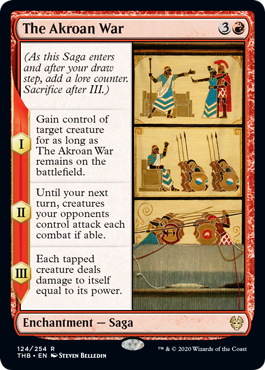
How did representation of the Gods, including the two-color Gods, change throughout the design of Theros Beyond Death?
I decided very early on that the new God cards should use the same devotion-based mechanic as the Gods from the original Theros block. Mechanics for Gods are really hard to design, and I’m sure we’ll want to go to new planes that have Gods in the future, so I wanted to conserve the design space for a place where novelty will be more valuable than in a “return to” set.
I was also keenly interested in finding out about the red-green God who had been around before Xenagos’s apotheosis. We saw a hint or two about her, on cards like Temple of Abandon. We hadn’t really captured Persephone, who split her time between the Underworld and the regular world in the old myths, in card form in the original Theros block. It seemed like a logical assumption that the old red-green God had simply been in the Underworld during the original Theros story. There was a lot of enthusiasm within Wizards for making a card of this character. We ended up straying quite far from Persephone’s character and portfolio in the end, making Klothys the God of Destiny.
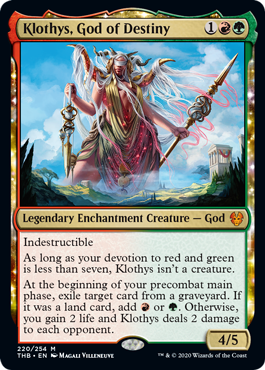
The line-up of which of the previous Gods were in the set changed a lot as we iterated. I don’t have a complete record of all the changes we made, but the hand-off from Vision to Set Design didn’t include Nylea or Purphoros. We had lots of Elder legends, including a cycle of five Elder Titans. As the Set Design team worked on the set, they pared down some of the Elders and replaced some of them with Gods, so that all five of the mono-colored Gods were represented, along with Athreos and Klothys.
How did the idea for the “demigod” creature type come about? Did it come up during the design of original Theros block?
During the design for the original Theros block, I pushed to get “hero” made into a creature type. The original connotation of the word “hero” is very similar to what we mean when we say “demigod” today. The rest of R&D wasn’t interested in adding the hero type at that time. We didn’t have demigods in Theros Beyond Death during Vision Design; it was added by the Set Design Team.
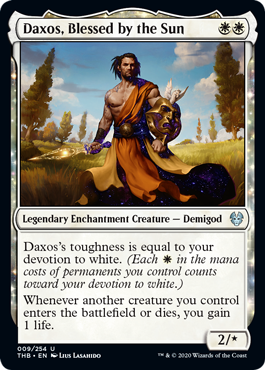
There were Theros-themed titans before Theros Beyond Death. Are any of them considered to be peers of the Elder Giants?
I doubt that there is much in the way of background material officially written about the non-Elder Titans. My personal opinion is that they are in some sense younger and less powerful than the Elder Titans. It’s important to realize that history is highly malleable in Theros, though. It’s a place where the collective unconscious can literally revise reality and history.

Did you know that Elspeth was going to end up with a weapon like the Shadowspear before working on Theros Beyond Death, or did it come up during its design?
The Shadowspear was invented by the folks working on the storyline after I finished my part of design. We knew that Elspeth was going to be the central character of the story and we had a rough idea about what was going to happen in that story, but a lot of the details were invented later.
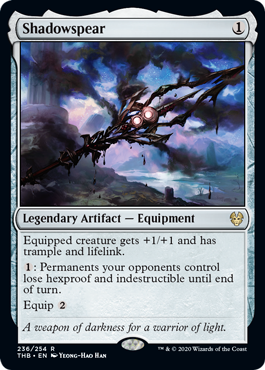
You tweeted about how the worldbuilding team and franchise team jointly created the Planeswalker Calix. Was this process something new to Theros Beyond Death, or has this happened before in previous sets?
The process of creating the Calix character was similar to that used to create Oko, I believe. The initial impetus to create the characters was slightly different; Oko was created to express a character archetype, and Calix was created to fulfill a mechanical gameplay function, but the process was similar. Recent Planeswalker characters that are counter-examples are Davriel and Teyo, who were created by authors for use in their fiction, and then adapted into the game by the game designers and character designers.

Did references to Gideon change throughout this set’s design before you ultimately arrived at designing Taranika? And was there ever consideration for a reference to Ajani in the set?
We had intended for some sort of memorial to Gideon to happen in Theros Beyond Death by the time we started Exploratory Design. The exact nature of that memorial changed as our plan for presenting the story changed.
The Planeswalker line-up for the set changed a lot as we worked on it. I believe that Ajani was going to be in the set, then we decided that a new character, Calix, would play into the set’s mechanical theme better. For a while, we were going to have Ajani as the face of one of the Planeswalker decks, similar to how Chandra headed up a Planeswalker deck in Dominaria. Eventually, we decided to simply use Elspeth there instead.
The gold token is back with The First Iroan Games! Was there any internal discussion about using gold versus treasure in the set?
There were many, many discussions about “Gold vs. Treasure.” Ultimately, the word “gold” serves the card so much better than treasure would have. After all, you win a gold medal in the Olympics!
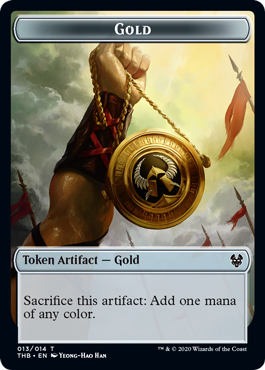
Any fun stories you can share from the design of Theros Beyond Death?
The original design vision for Theros Beyond Death included the Adventure mechanic from Throne of Eldraine! We were keen to find opportunities to carry mechanics forward between sets that are in the same rotation period in Standard. We had enchantments that went on adventures! That was… kinda weird, actually – which is probably why the Set Design team cut the mechanic from THB.
Thanks for devoting the time to talk Theros Beyond Death! Anything else you’d like to share?
Theros was the first world that we’ve made for Magic that I had influence over. To me, designing Theros Beyond Death has been like coming home. I hope that the folks out there who played with the original block feel the same way. And to those who haven’t had the chance to battle with and against Gods, heroes, and monsters, you have an epic journey ahead of you! Have fun!
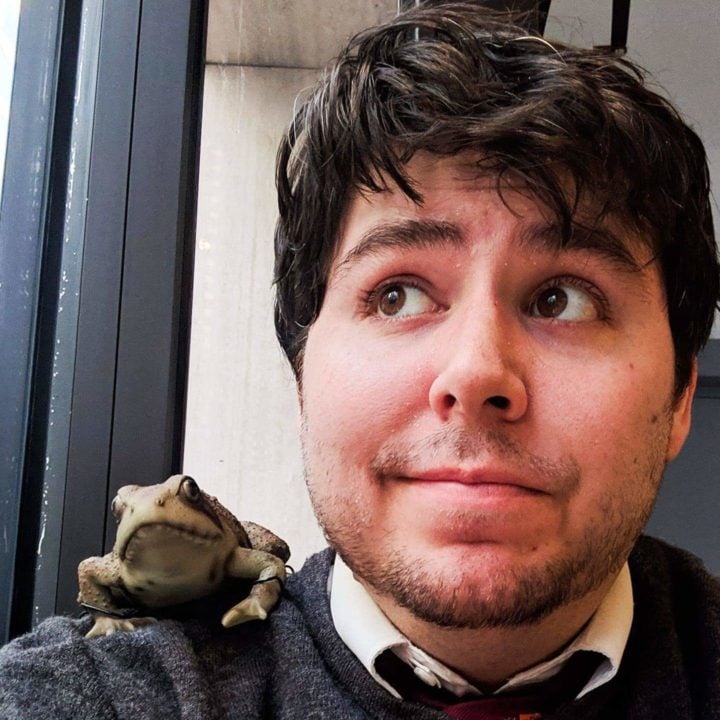
Bradley is a co-host of a weekly Magic: The Gathering design podcast, Beacon of Creation. He was among the Top 101 contestants in Wizards of the Coast’s Great Designer Search 2. He enjoys crafting custom Magic product experiences, like Archfrenemies, and building Commander decks with creative constraints.

